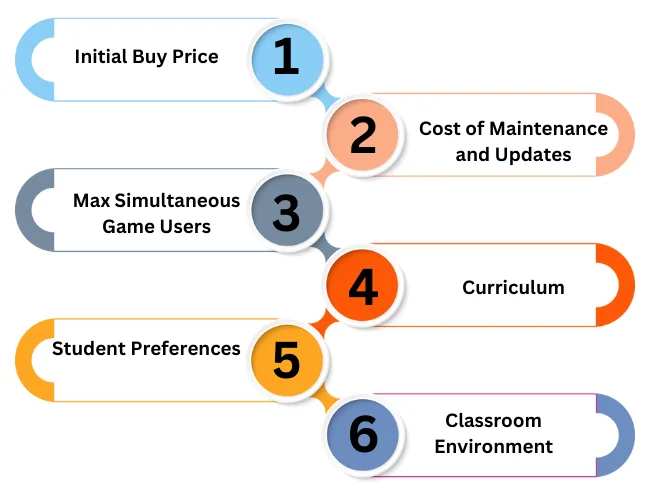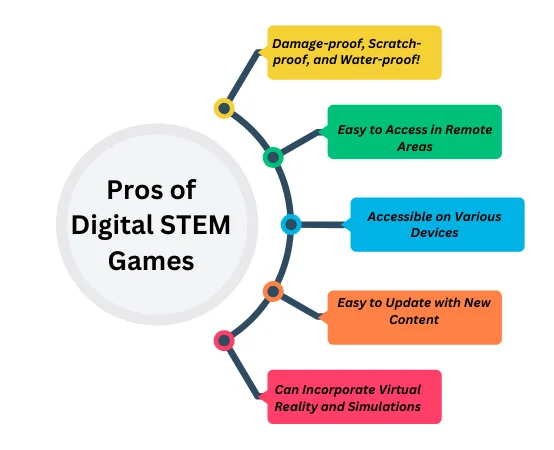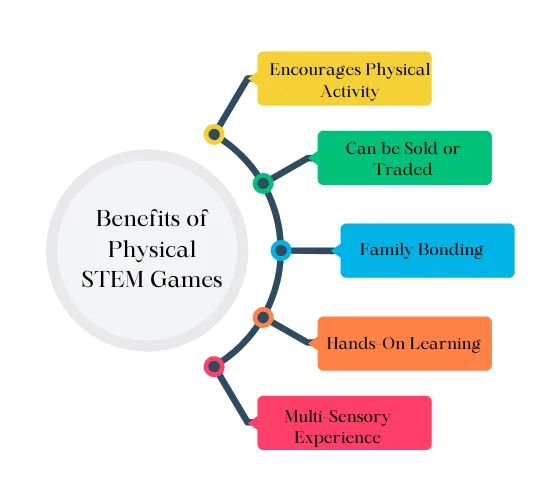The days of relying on physical board games or building sets are gone. Now, we have plenty of options available in the digital world. Questions still arise about which STEM game format is better. Either ‘digital’ or ‘physical’ is effective for learning and education purposes. Let’s dive into this showdown!
Both have their unique benefits, and it comes down to personal preference. Digital games offer a more immersive and interactive experience. Such experiences include 3D graphics, virtual reality, and simulations. This makes a more engaging and adventurous experience for students. Physical games offer a tangible and tactile experience that digital formats cannot replicate. Building sets and board games also allow for face-to-face interaction and socialization.
The Rise of Digital STEM Games
In 2022, a report by Global Market Insights stated that the market size for digital educational games reached $399.2 billion. It is expected to reach a market value of $1 trillion by 2032. This meaningful growth can be attributed to the increasing adoption of technology.

With the rise of smartphones and tablets, anyone can download a game and start playing within minutes. This has made digital games more appealing to younger players. Digital games incorporate interactive graphics and simulations that make learning more impressive.
Digital games allow for frequent updates and modifications, making them a more dynamic learning tool. A study by the University of Bristol found that students who used educational video games had higher levels of understanding.
Which Format is More Cost-effective for Schools: Digital or Physical STEM Games?
When it comes to STEM education, there are two main formats for games: digital and physical. Both have their advantages and disadvantages. The best choice for a particular school will depend on many factors. These factors are budget, curriculum, and student preferences.
Digital STEM games are played on computers, tablets, or other electronic devices. They can be approached from anywhere with an internet connection. Digital games can be customized and updated. This makes them a good choice for schools. Schools will stay up-to-date with the latest educational trends.
Physical STEM games are played with physical objects like blocks, gears, and magnets. Physical games are hands-on and tactile. These games help students to develop fine motor skills and spatial reasoning. Students can work together to build and solve problems.
Factors to Consider While Choosing Between Digital and Physical STEM Games
Factors to consider while choosing an effective STEM game are:

- Initial Buy Price: Digital games are often more expensive than physical games. Schools sometimes need to buy many licenses for digital games. But digital games can also be used by more students at the same time, so the cost per student can be lower.
- Cost of Maintenance and Updates: Digital games need regular updates to include the latest educational trends. These updates can be costly, and they can add up over time. Physical games do not need updates so they can be more cost-effective in the long run.
- Max Simultaneous Game Users: Many students can use digital games at the same time. While physical games are limited to one or two students at a time. This makes digital games a more cost-effective option for schools with large class sizes.
- Curriculum: Some STEM games follow specific curricula, while others are more general. Schools should choose games that align with their curriculum to ensure students learn the material they need to know.
- Student preferences: Some students prefer digital games, while others prefer physical games. When choosing games, schools should consider student preferences. It will help to make sure students are engaged and motivated to learn.
- Classroom environment: The classroom environment can also impact the choice of STEM games. Digital games are best suited for classrooms with access to computers and tablets. Physical games are best suited for classrooms with open spaces for students to move around.
Comparison Between Digital and Physical STEM Games
| Digital STEM Games | Physical STEM Games |
|---|---|
| 1. Interactive | 1. Hands-on |
| 2. Can be played anywhere and anytime | 2. Require specific materials and space |
| 3. Easy to access through devices such as computers, tablets, or mobile phones | 3. Physical presence required to access and play |
| 4. A wide variety of options are available | 4. Limited options with specific game sets |
| 5. Can be easily updated and expanded | 5. Difficulty in updating or expanding the game set |
| 6. Cost-effective as no more materials are needed | 6. Extra expenses for purchasing materials and game sets |
| 7. Can track progress and provide feedback | 7. Limited or no tracking of progress and minimal feedback |
| 8. Offers virtual simulations for practical learning | 8. Provides hands-on experience for practical learning. |
Pros of Digital STEM Games
The advantages of digital games are:

Damage-proof, Scratch-proof, and Water-proof!
Game developers create digital STEM games to be played online or on a computer. This means that they do not need any physical components such as game boards, cards, or pieces. As a result, these games are damage-proof and scratch-proof. There is no risk of them getting damaged due to mishandling or wear and tear.
Easy to Access in Remote Areas
Digital STEM games can be accessed from anywhere with an internet connection. This includes remote and rural areas where access to physical resources is limited. Children in these areas can have access to interactive learning experiences.
Accessible on Various Devices
Digital STEM games are not limited to a specific device or operating system. They can be approached on computers, laptops, tablets, and even smartphones. This versatility allows children to play the games anytime, at any location.
Easy to Update with New Content
Digital STEM games can be easily updated with new content. Updates to ensure that the learning experience remains fresh and relevant for children. This allows continuous improvement of the game.
Can Incorporate Virtual Reality and Simulations
Digital STEM games can incorporate virtual reality and simulations. This allows children to experience concepts in a more immersive and interactive way. Such incorporation can enhance their understanding and retention of the material.
The Benefits of Physical STEM Games
The benefits of physical games are:

- Encourages Physical Activity: Many kids spend much time in front of screens playing video games. Physical STEM games offer a fun and engaging way for kids to get up and move around.
- Can be Sold or Traded: Physical STEM games can be easily sold or traded with other individuals. This helps to save money by reducing the need to buy new games. It helps kids make friends and talk to each other as they share and trade games.
- Family Bonding: Physical STEM games offer time for families to bond and spend worthy time together. These games involve building a robot, solving puzzles, and conducting science experiments. They provide a fun and collaborative activity that the whole family can enjoy.
- Hands-On Learning: In physical STEM games, kids build, assemble, or play with real objects. This hands-on method helps children develop motor skills, understand space, and solve problems.
- Multi-Sensory Experience: Physical STEM games engage many senses, such as touch, smell, and even taste. It makes the game more fun and exciting for children.
Wrapping Up
- Both digital and physical STEM games offer unique advantages
- Digital games provide an immersive experience with 3D graphics and virtual reality
- The digital market reached $399.2 billion in 2022 and is expected to hit $1 trillion by 2032
- Physical games offer a tangible, hands-on experience promoting socialization and fine motor skills development
- Factors influencing the choice include cost, maintenance, curriculum alignment, student preferences, and classroom environment
- Digital games offer easy accessibility, cost-effectiveness, and progress tracking
- Physical games encourage physical activity, family bonding, and multi-sensory engagement
- The decision depends on schools’ specific needs and preferences, considering budget constraints, class sizes, and desired learning outcomes






